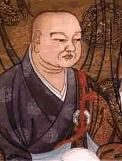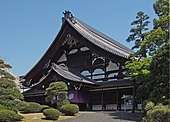Sōji-ji
| Sōji-ji 總持寺 | |
|---|---|
Shaka Nyorai (Śākyamuni) | |
| Status | Head Temple |
| Location | |
| Location | 2-Chōme 1-1 Tsurumi, Tsurumi-ku, Yokohama, Kanagawa Prefecture |
| Country | Japan |
| Geographic coordinates | 35°30′25.16″N 139°40′17.25″E / 35.5069889°N 139.6714583°E |
| Architecture | |
| Founder | Gyōki (acc. legend) Keizan (conversion) |
| Completed | Nara period (acc. legend) 1911 (relocation) |
| Website | |
| http://sojiji.jp/ | |
Sōji-ji (總持寺) is one of two daihonzan (大本山, "head temples") of the
History

Giving it the name Morooka-dera (諸岳寺) circa 740, Gyōki (668–749) founded the temple as a Shingon Buddhist temple in Noto, a peninsula on Honshu, Japan's largest island. At that time, the temple was a small chapel within the precincts of a larger Shinto shrine called Morooka Hiko Jinja. By 1296, the temple had grown enough to support a full-time priest and a master ajari named Jōken was assigned there.[6]
The Shrine was relocated 1321 to a new estate and Jōken went with it. Jōken entrusted the former temple to
The temple was totally destroyed by fire in 1898. It was rebuilt over a period of several years and, to bring more Sōtō Zen to eastern Japan, reopened in 1911 in its present location at Tsurumi, Yokohama. Sōji-ji-soin (the "father" temple)[9] was built on the original Noto site for monks in training. It sustained considerable damage in the 2007 Noto earthquake.[10]
Routine

According to a mid-20th century description, the monks' day begins at 3 a.m. in summer and one hour later in winter. First they practice
Abbot
The
Temple compound

The core of the temple consists of seven structures forming the so-called
Among outreach activities, the Sōji Gakuen Academy is a school system where the students study the Buddha's teaching. The academy has a kindergarten, middle school, high school, and university. Sōji also has child care and a hospital.[12]

The Koshakudai holds the monks' living quarters.[4]
School

Affiliates
- Komazawa University
- Tohoku Fukushi University
- Aichi Gakuin University
- Tsurumi University
- Komazawa Women's University
- Tomakomai Komazawa University
- Komazawa Junior College
- Komazawa Senior High School
- Komazawa Iwamizawa Senior High School
- Komazawa Tomakomai Senior High School
Branches
- Sōjiji-soin (総持寺祖院) in Ishikawa Prefecture
- Hōgen-ji (法源寺), also known as the Sōjiji Hokkaidō Betsuin (総持寺北海道別院), in Matsumae
In the United States
- Zenshuji Soto Mission
See also
Gallery
-
The entrance
-
Daisō-dō orHattō, the main training center, designed by Itō Chūta
-
Sunrise 2007
-
A painting of Bodhidharma in the reception hall
-
The meditation hall, or shuryō (衆寮)
References
- ^ "Touring Venerable Temples of Soto Zen Buddhism in Japan Plan". SotoZen-Net. Retrieved March 16, 2012.
- ^ a b "Soji-ji". Random House. Retrieved March 15, 2012.
- ^ a b "Head Temples". SotoZen.net. Retrieved March 15, 2012.
- ^ a b c "Sojiji". A Guide to Kamakura. Asahi net. March 2012. Archived from the original on March 4, 2012. Retrieved March 14, 2012.
- ISBN 978-0-19-532677-2.
- ^ ISBN 978-0-8248-3303-9.
- ^ "Kanji for JI". jp41.com. Retrieved March 15, 2012.
- ^ ISBN 978-0-8248-3303-9.
- ^ "Daihonzan Sojiji Soin Temple". Noto Style. Retrieved March 16, 2012.
- ^ "Sojiji Temple". Japan Guide. Retrieved March 15, 2012.
- ^ "A Soto-Shu Monk" (PDF). Zen Notes. 1 (4). First Zen Institute of America. April 1954. Retrieved March 16, 2012.
- ^ a b Sotoshu Shumucho (planner and producer), Kindai Eiga Kyokai (production). Life of Zen. SotoZen.net. Event occurs at Sojiji 5:00, 6:45, 8:28, 9:45. Retrieved March 15, 2012.






